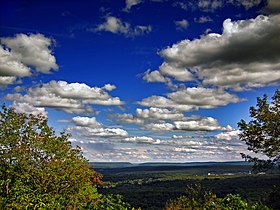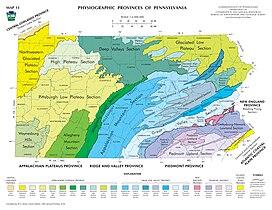Poconos
| The Poconos | |
|---|---|

View from Mount Pocono Lookout
|
|
| Highest point | |
| Peak | Camelback Mountain (Big Pocono) |
| Elevation | 2,133 ft (650 m) |
| Coordinates | 41°2′30.84″N 75°20′44.88″W / 41.0419000°N 75.3458000°WCoordinates: 41°2′30.84″N 75°20′44.88″W / 41.0419000°N 75.3458000°W |
| Naming | |
| Etymology | Lenape Indian term for "stream between two mountains". |
| Geography | |
| Country | United States |
| State | Pennsylvania |
| Counties | |
| Parent range | Glaciated Allegheny Plateau |
The Pocono Mountains, commonly referred to as the Poconos, is a geographical, geological, and cultural region in Northeastern Pennsylvania, United States. The Poconos are an upland of the larger Allegheny Plateau. Forming a 2,400 square miles (6,200 km2) escarpment overlooking the Delaware River and Delaware Water Gap to the east, the mountains are bordered on the north by Lake Wallenpaupack, on the west by the Wyoming Valley and the Coal Region, and to the south by the Lehigh Valley. It comes from the Munsee word Pokawachne, which means "Creek Between Two Hills." Much of the Poconos region lies within the Greater New York-Newark, NY-NJ-CT-PA Combined Statistical Area. The wooded hills and valleys have long been a popular recreation area, accessible within a two-hour drive to millions of metropolitan area residents, with many communities having resort hotels with fishing, hunting, skiing, and other sports facilities.
The Pocono Mountains are a popular recreational destination for local and regional visitors. While the area has long been a popular tourist destination, many communities have seen a rise in population, especially in Coolbaugh Township and other communities within Monroe County. The region has a population of about 340,300, which is growing at a rapid pace, largely attributable to vacationers from New York and New Jersey turning vacation homes into permanent residences. The region lacks a major population center, although there are municipalities such as Stroudsburg, East Stroudsburg, Mount Pocono, and the townships around them which are all in Monroe County where the population is 165,058, which is about half of the total population in the Poconos.
The Poconos now serves as a commuter community for New York City and northern New Jersey. The commute often takes as much as two hours each way due to traffic.
...
Wikipedia

